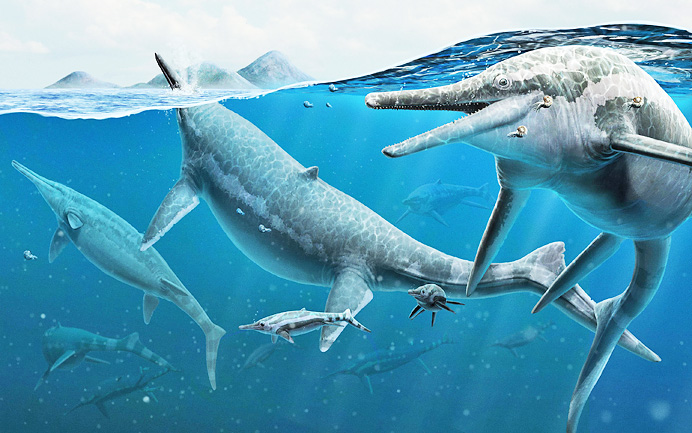Mark Johnson
THE WASHINGTON POST – Fossil experts believe they have solved a decades-old mystery: How did at least 37 school-bus-size marine reptiles die and become embedded in stone about 230 million years ago in what is now central Nevada?
If the scientists from the Smithsonian National Museum of Natural History and other institutions are correct, the fossil graveyard near an old silver mine represents an early example of migration, one of the most fundamental and deeply ingrained of all animal behaviours.
The bones found at the Nevada site come from the giant ichthyosaur Shonisaurus, which resembled an enormous, out-of-shape dolphin. Shonisaurus glided barge-like thousands of miles through an ocean known as Panthalassa, the ancient version of today’s Pacific, to breed and deliver their offspring, according to a new study in Current Biology.
The finding offers a rare window into the behaviours of pre-historic animals, something that is not always captured by individual fossils.
It raises the possibility that further clues embedded in sediment and soil may offer a deeper understanding of marine reptiles that inhabited the planet long before humans.
The earliest known evidence of migration dates back more than 300 million years to ancient Bandringa sharks with long spoon-bill-shaped snouts and prehistoric fish with armoured plates.
Today billions of animals migrate, including species as diverse as hummingbirds and humpback whales, monarch butterflies and blue wildebeests.

Clues from similar fossils found in other regions suggest that Shonisaurus migrated to central Nevada from parts of modern-day California, Alaska and New Mexico.
If so, that behaviour could link the pre-historic Shonisaurus, the largest creature to travel the oceans in the Triassic period, with modern giants – the blue whales observed today with their calves in the Gulf of California.
Whales tend to migrate to warmer waters to give birth, and then to cooler waters that are rich in nutrients. “One has to wonder if the same ecological rules are at play even though there are over 200 million years between (whales and Shonisauruses),” said one of the new paper’s authors Nicholas D Pyenson who works in the department of paleobiology at the National Museum of Natural History.
Not all experts in the field believe Pyenson and his colleagues have solved the mystery surrounding the great abundance of Shonisaurus bones at the site and the absolute absence of any other ichthyosaurs.
“This study is probably not the final word, but it’s a good step forward,” cautioned a professor of palaeontology Martin Sander at the University of Bonn in Germany and a research associate at the Natural History Museum of Los Angeles County. Sander, who was not involved in the study, added “I’m not entirely convinced. It’s a good idea but it’s awfully difficult to prove.”
The skeletons at Berlin-Ichthyosaur State Park in West Union Canyon show that the Shonisaurus grew up to 50 feet, five times the length of a modern dolphin, and weighed about 22 tonnes, the equivalent of three large elephants. Their offspring were only a few feet long. A University of California at Berkeley palaeontologist Charles L Camp was the first to excavate the alternating layers of limestone and mudstone at the site in the 1950s.
He immediately wondered what might account for the large cluster of Shonisaurus skeletons.
“He thought it might be a mass stranding,” like those involving whales, said another of the paper’s authors and an assistant professor in Vanderbilt University’s department of earth and environmental sciences Neil P Kelley.
But the fossil evidence disproves that hypothesis, showing that the skeletons had settled underwater far from shore. The effort to explain why Shonisaurus bones have so far been the only ichthyosaur fossils discovered at the Nevada site became a feat of scientific detective work. Researchers combined 3D scanning and geochemistry with more traditional tools such as museum collections, field notes, photographs and archival materials.
They came to view migration as the most likely scenario after eliminating other possibilities.
Testing the sediment revealed an absence of mercury levels that would have signalled volcanic activity, which is believed to have caused the largest mass extinction 252 million years ago. Researchers were also able to eliminate the possibility that a deadly algal bloom poisoned the marine reptiles.
In the end, only the migration scenario appeared to make sense.
“Shonisaurus occurs at other locations so the genus had a broad geographic range, and it is very reasonable that these large individuals travelled long distances, as most large marine vertebrates do today,” Kelley said. “It should be possible to gather additional data in the future which could test the hypotheses we present in the paper, including migration.”







